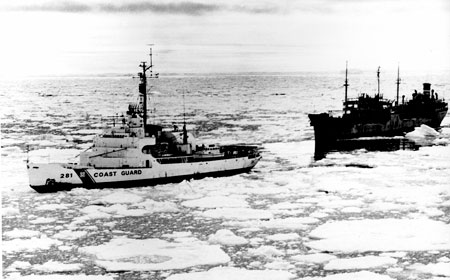
Among the many missions of the U.S. Coast Guard, icebreaking is viewed as a rather
narrow specialty. However, the specialty consists of a wide range of tasks –
from the support of science expeditions to saving lives on frozen waters. Icebreaking
supports national defense, maritime safety, international trade, the global economy,
and the lives of citizens.
1830s – The origin of icebreaking appeared
along with the advent of steam propulsion. It was found that side-wheel steamers
with reinforced bows could deal with harbor ice, a problem in East Coast ports.
1867 – The U.S. purchased Alaska, creating
another need for vessels that could cut through ice. The Revenue Cutter Service’s
Lincoln, a conventional wooden steamer, became the first of many vessels
to operate in Alaska.
1874 – The vessel Bear was built
and became the Coast Guard’s first “ice-resistant” vessel.
She was 198 feet in length and was built with extraordinarily strong wooden construction.
She was framed with English oak wood and had iron plating on her stern.
1899 – The Russian government accepted the
British vessel Ermack, which is considered the first true icebreaker.
She was 10,000 tons with 10,000 horsepower and had 1.5-inch plating at the waterline.
She became the prototype of future icebreakers.
1908 – The cutter Androscoggin was
commissioned. She was purposefully built as a cutter to break through the ice
along the Maine coast for the relief of shipping. She had 1,600 horsepower,
a spoon bow and was strongly built of white oak, with steel reinforcement and frame.
The Androscoggin was the last major naval or Coast Guard ship to have a wooden
hull.
1927 – Bear was retired, and it
was obvious that the Coast Guard needed to rebuild their icebreaking fleet.
1935 – The Escanaba-class of vessels
for U.S. Coast Guard ice operations was completed. These vessels were intended
for light icebreaking on the Great Lakes and included the Escanaba, Tahoma, Mohawk,
Comanche, Algonquin, and Onondaga. Built of steel, the 165-foot
cutters had double plating on the bow allowing them to break over a foot of ice.
December 21, 1936 – President Theodore Roosevelt
issued Executive Order No. 7521 which directed the Coast Guard “to assist in
keeping open to navigation by means of icebreaking operations… channels and
harbors within the reasonable demands of commerce.” After this directive,
the Coast Guard initiated an intensive study of icebreaker technology with the goal
of building the first line of heavy vessels primarily for icebreaking.
1939 – The Raritan-class was commissioned
and included the Arundel, Naugatuck, Mahoning, and Raritan.
WWII – The Coast Guard icebreaker’s
biggest contribution to World War II was in Greenland waters. President Roosevelt
had pledged U.S. support to Denmark in resisting any Nazi attempt to take the island,
protecting the security of the Western Hemisphere. The U.S. Coast Guard became
a major part of the Greenland patrol, operating 24 vessels in her waters, about eleven
of which were equipped for icebreaking. The cutter Northland carried
out the first American naval capture of the war in September 1941, three months before
Pearl Harbor.
1941 – The “Wind” class icebreakers
were contracted.
1944 – The “Wind” class icebreakers
were completed.
1950s – The Artic became a focus, with U.S.
military bases in the region requiring periodical resupplying.
1955 – The first Operation Deep Freeze to
the Antarctic continent began. These vital scientific and exploratory expeditions
became an annual commitment, involving at least one heavy duty icebreaker in each.
1957 – The first transit of the Northwest
Passage across the “top” of North American occurred, involving the cutters
Storis, Spar, and Bramble. The Spar became the first
American vessel to circumnavigate the North American continent.
1965 – The number of major icebreakers in
the Coast Guard multiplied, as the result of an agreement with the U.S. Navy.
A joint study on icebreaker utilization concluded that efficiency would be served
best by combining all icebreaking under the Coast Guard. The Navy transferred
all icebreakers over to the service.
1968 – The discovery of oil on the North
Slope of Alaska added a new dimension to Coast Guard duties in Arctic waters.
1973 – The Coast Guard launched the USCGC
Polar Star on November 17, considered the largest icebreaker in the western
world.
1980s – the Coast Guard continued to add
to its fleet of icebreaking tugboats, replacing the Raritan-class with nine
140-foot tugs
1994 – The Polar Sea became the
first U.S. surface vessel to reach the North Pole on August 22.
1998 – The CGC Healy was launched.
Designed by both the Navy and the Coast Guard this new vessel was designated both
a Polar icebreaker and a research vessel.
For icebreaker history since 2000, please visit the
section titled “Recent History.”
